There sure are a lot of opinions out there about how and where to charge your ebike battery when on the road. There are two schools of thought out there. The respectable, considerate types will ask permission before they plug in anywhere in the hopes that people will say yes to their request (they almost always do). Delinquent types like myself tend to just do whatever they want to and see what they can get away with. This article is aimed at degenerates who prefer to ask for forgiveness rather than permission when it comes to charging their ebike batteries. There is no shortage of online ebikers who will tell you “You’re making us all look bad, don’t guerilla charge” to which I say … ‘meh’. With electricity at about 12 cents a kWh as a national average, technically yes you’re talking about theft of services, but what criminal justice system in its right mind is going to prosecute you for stealing less than 10 cents worth of electricity? That’s assuming that the American criminal justice system is in any way fair or reasonable which is a pretty stupid assumption. It’s less about what is legal and more about doing what reasonable and expected vs being rude and disrespectful of people’s boundaries.
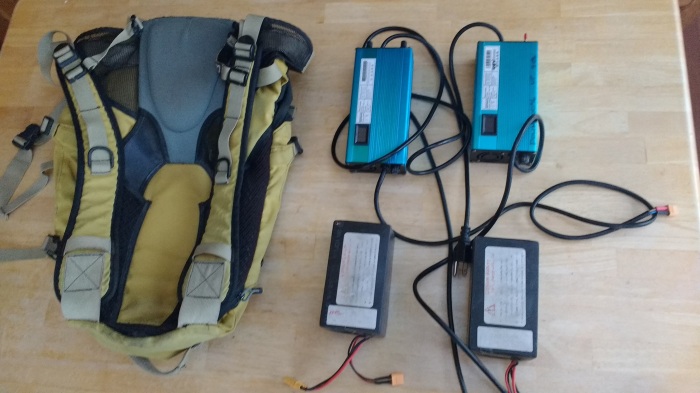
My Guerilla charging setup, 12Ah of batteries that I can fully charge from any outlet in about 45 minutes
There are a lot of different ways to deal with ebike charging. I live 17 miles from town so I usually leave chargers at home and at my son’s mother’s house who lives in town. When I ebike into town I just throw my dead battery on the charger and swap it out for a battery that I keep charged there and ride around town on my backup battery. By the time I’m done seeing customers I go back to my son’s mother’s house and swap the batteries back and ride home. Now this assumes that you have a place at your destination to charge, which if you haven’t been really nice to your Ex then you might not. It could be a friend’s house, it could be work or a customer site. Just find somewhere at your destination that you can store a charger and an extra battery. If you can’t do that there is still a lot of options.
Most people ask for permission to charge their ebike batteries, which is the better option if you’re thinking you’re going to want to charge at that spot on a regular basis. I would ask like this;
I’m wondering if it would be OK to charge my stuff here for a few minutes while a patronize your business?
Do you need to tell them that you’re charging a 1Kw ebike battery pack? Not really. If they ask you can tell them but for the most part they will just assume it is a laptop or something. I keep my chargers and my ebike batteries in a backpack and then just run the power cable to the plug and let it all charge inside of the open backpack. Leaving the backpack open will allow the batteries to cool a bit at air to flow through the charger.
Most wall outlets are rated for 15Amps at 120V AC which means they should be able to provide 1800W of power. In reality, most circuit breakers will flip if you try to pull more than about 12Amps for any length of time (about 1500W). Another problem I’ve seen is that if you pull over 12Amps of power many plugs will actually melt after a while even if the circuit breaker does not flip (yup you read that right, the outlets and adapters will melt). Something else to think about is that you have to remember there are generally other things on the same circuit as you and if the load for the whole circuit goes over 1500W the circuit breaker will probably flip. I would recommend the optimal charging rate as somewhere in the 600-700W range. I would not even think about charging over 1000W on a normal 15 Amp plug for any length of time. When you do that you are begging for problems.
A high quality charger like the Cycle Satiator will charge up to 8Amps on a 36-60v pack (about 500W) but it costs about $300 which is a lot for an ebike charger. In general, when I’m on the road I end up using 2 different 30Q Mini Cubes (6Ah each) and hook them up to two different 5 Amp cheap ass Luna chargers (at about $80 each). Although it is a pain to use two chargers it gives me redundancy in case one charger fails, it allows me to pull closer to 600W out of a single outlet and it puts less heat and strain on each outlet plug decreasing the chances of the outlet melting on me. I know the whole melting outlet thing sounds crazy, but I’ve had it happen several times already. At my wife’s house which is solar powered off-grid system we have a 1000W charger that runs off the propane powered generator that plugs into a special plug that is supposed to be able to support 20Amps and it has still melted on us twice. I’ve also had several 15Amp outlets melt in the house from running small electric 800W space heaters. These funny looking frowny face 15Amp 120V outlets that haunt my nightmares are just not designed for that much power for extended periods of time.

With 2 Luna Mini 30Q packs I can ride for 2-3 hours (PAS) and charge both of them in tandem from the same outlet in about 50 minutes at 5 Amps each, and the packs barely get warm. The 30Q cells are really amazing.
Another big question that you have to answer for yourself is how much power can you charge your pack with without damaging the cells. This will vary from pack to pack and BMS to BMS. Many ebike batteries ship with a 2Amp charger but can still charge at a higher rate if you want to without stressing the cells or the BMS. Make no mistake, charging ebike batteries at higher rates will lower the total number of life cycles of your batteries. 18650 cells hate heat and higher charging rates mean more heat. More heat means a shorter life, there is no way to get around it. Many of the frame packs (Dolphin, shark, killer whale, etc) have a barrel plug adapter for charging. These barrel plugs work fine a 2-3 amps but there is a good chance you could melt the plug by charging for extended periods of time with 5 amps. I’ve done it and not had a problem, but I’m not saying that it is in any way a good idea at all.
When you get a new pack the best thing to do to find out its max charging rate is to test it at different rates to see how warm it gets. If a pack or BMS is getting warm when charging then that means you need to back off or trouble will ensue. My belief is that the pack should only increase in temp less than 10 degrees above the ambient room temp when charging for a soft pack and 5 degrees above ambient room temp for a frame pack (they hold heat in much better). If your pack is getting hotter than that then you are probably charging it with too many amps. The newest Lunagizer chargers have a variable charging rate (1,2,3,4 or 5 Amps) and it is the charger that I use pretty religiously since I had a cheap Chinese charger from a generic ebay seller blow up in my living room. Luckily it was just a large capacitor that blew up, but when I took apart the Chinese charger I was horrified at what I saw. Long story short, I don’t trust cheap Chinese chargers and I have given all mine away to people that I don’t like (let their houses burn down).
Where or where to charge?
This is the million dollar question and a lot of it will depend on where you are when you batteries are dead. Best places to free charge are
- Ebike Shops
- Public Libraries
- National Parks
- College Campuses
- Coffee Shops
- Grocery Stores with nice sit-down dining areas
- Fast food restaurants (although many outlets often have plates covering them up)
- Campgrounds that you’re already staying at
- Your Local Friendly Bike Shop (unless they don’t like ebikes, which some shops don’t)
- Outside outlets at any Walmart store
- Soda Pop \ Vending Machine outlets
- Town park pavilions
- Public EV spots or Residential Plug Shares on the Plug Share app located here (You may need a J1772 custom adapter for EV chargers, PITA)
- Makerspaces
Most of these places will always say yes if you ask to charge your batteries. As long as you’re not melting outlets and blowing circuit breakers you’ll probably never have any problems. Other places to charge that might ask you to pay for the electricity
- Gas Stations
- Campgrounds that you’re not staying at
- Non-fast food restaurants
I find it insane that anyone would ask you to pay several dollars for a dime or two worth of electricity. If you’re desperate enough to pay it, well then good for you, you are a better person than I am. Many campgrounds also have 30Amp plugs which you can pull much more power from much more quickly but also require an adapter cable to work with a normal 15Amp charger. I think for most ebike batteries charging from a 30 Amp plug is such an overkill I’m not even going to really discuss it here, although people have done it. The hassle of charging from a 30 amp or J1772 EV charger is not worth the small amount of time you will save, not to mention the additional stress on the BMS and cells from high Amp rate charging.
If you do want to ask then make sure you mention that you’re going to patronize the business or offer to help clean up litter or something like that. I wouldn’t offer to pay for the electricity (they don’t want your nickel anyway) and if you offer to pay then it makes it seem like you’re taking several dollars worth of juice which is simply not the case. Being friendly and courteous can go a long way, but it’s not a skill I’m particularly versed in so we’ll just move on.
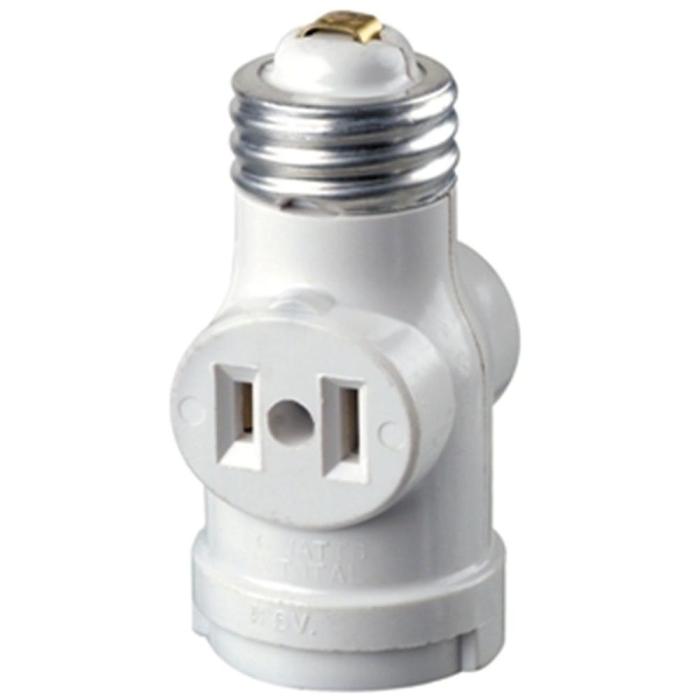
If you lose the ground plug on your AC cord then some other REALLY crazy options open up for you. I would not trust pulling more than 200 Watts through this $3 Home Depot special. This fits firmly in the ‘bad idea’ category.
Get the battery off the damn bike
For the love of all things that are good, when building an ebike that you will want to charge while on the road make sure the battery is removable. If you have an ebike with a non-removable battery that severely limits your ability to effectively Guerilla charge. There are ebikers who ride around with really long extension cords to charge their ebikes with non-removable batteries, but I would not recommend that you be one of those people. The whole idea behind ebike Guerilla charging is that you don’t want people to know that you’re charging ebike batteries to begin with. You want them to think you just have a laptop or something like that in your backpack. When you have an ebike with a power cord coming out of it then where is the mystery in that?
Is that dishonest? Are we intentionally misleading people? Probably. Do I care? Not really.
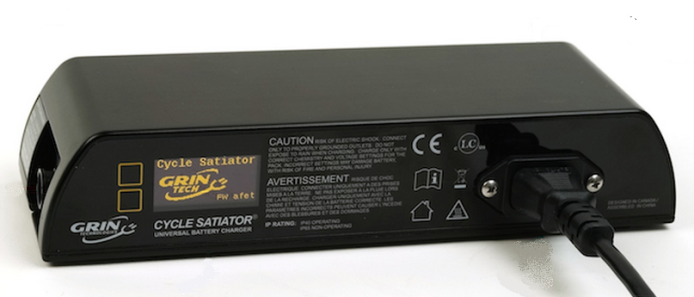
The Grin Tech Cycle Satiator is the best charger on the US market right now, but pretty pricey at over $300
Skip the balancing cycle
Once the batteries get full charged (about 58.5v on a 52v charger or 54.3v on a 48v charger) then the BMS will start going through a balancing cycle for the cells. This process usually takes quite a long time and for Guerilla charging it is really not necessary. When the battery gets over 58v on a 52v charger or over 54v on a 48v charger I generally just unplug it and go. It’s nice to have a charger with a voltage display on it, and although my first 2 Lunagizer chargers both had the LED display burn out within 6 months of purchase, all my more recent Lunagizer chargers have not had any problems with the voltage displays. I currently have about 7 Luna chargers around the house and I can’t say enough good things about them. It’s all I ever use anymore.
AC Inverters hooked up to your car
I’ve had limited luck with using AC inverters to charge ebike batteries. The problem is that most 12V plugs on your car will only put out about 100 Watts or so. You can do this if you buy a large inverter then run thick wires through the firewall of the car and connect it directly to your battery. I have a 3500W inverter on my Sprinter RV conversion that I can charge my ebike batteries when it is running, but I used very thick 1 gauge wires to the inverter which is a total overkill for this application. The closer the inverter is to the battery the more power you’ll get, the farther away to mount it the thicker wire you need to use. Make sure to turn the inverter off when not in use or it will kill your battery with the leech load. Also be aware that cheap powerful inverters can fail catastrophically and dump power to the ground which could possibly shock you as you exit the vehicle. I’ve not had this happen but I’ve heard horror stories on the internet.
It’s not a bomb … Really officer
One of the worst places that I’ve tried to charge batteries at is the Airport. I actually had the police called on me because they thought it was a bomb. The Dept of Homeland Security goon was not particularly pleasant to deal with and he threw me out of the airport. (true story) I don’t get along well with police and I have gotten the crap beat out of me by the cops more than once (my teenage years were boring, suspicious cops made it way more exciting). When we were young we’d take off running every time we saw a cop just to see if we could get them to chase us. I stopped doing that when the cop pulled out his gun and told me to stop or he was going to shoot. That was a fun night that ended up with a $200 ticket. *sigh* At least I didn’t get shot.
I would not charge your ebikes at any public schools unless you are a student of that school. With the violence and drug problems in public schools it seems like every school I visit has more and more fencing and more adults watching everything that happens inside of the fences very, very carefully. Why risk the extra attention when there are so many other free places around to charge?
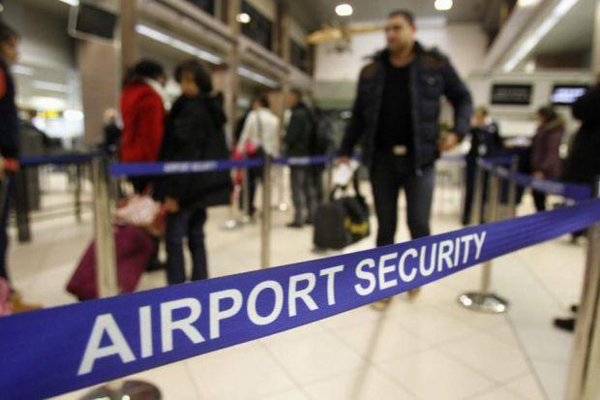
Airports are hands down the worst places to charge ebike batteries (except the police station, or your exgirlfriend’s house)
Whether you ask for permission or forgiveness is a call everyone will have to make for themselves. On one hand, you can be a good steward for the ebike world and not take advantage of other people’s ignorance or generosity. On the other hand, you can be a selfish prick who takes whatever they want whenever they want without asking permission first. I’m the latter, it would be better for everyone if you were not like me. The best way to be a good steward is to ask permission first, not to melt their outlets, throw circuit breakers or have your batteries and chargers blow up in public places.
I think the most important part of the whole process is to not leave your expensive ebike batteries charging unattended. This invites theft or charging problems, always stay within clear line of site of your ‘stuff’. Someone should really be there when the cops show up, and that someone should probably be you.
Ride on.
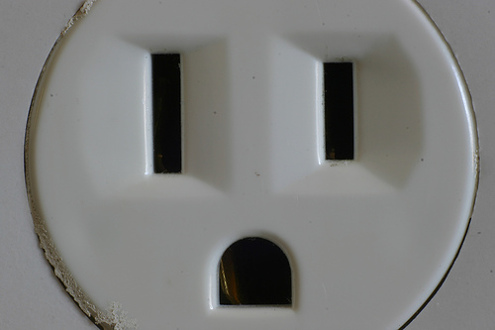
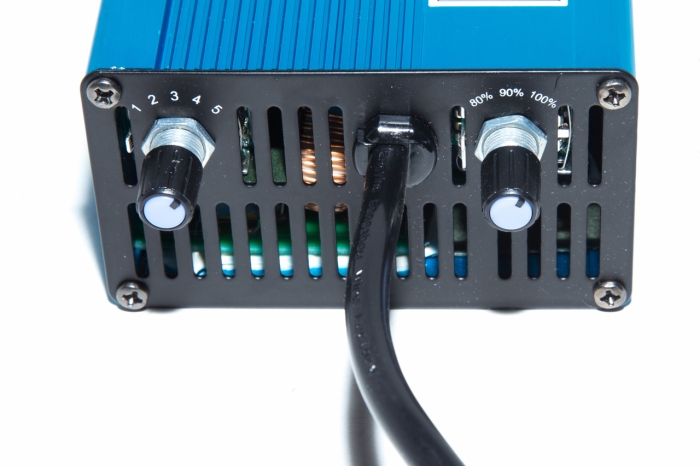

No comments:
Post a Comment